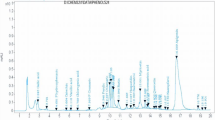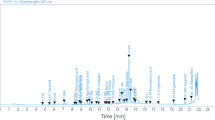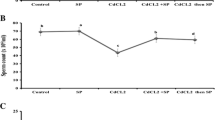Abstract
Cadmium (Cd) is known for its many toxic effects on male population such as hypogonadism and fertility difficulties, which are oftenly associated with oxidative stress. As beneficial food, Spirulina(Sp) has been proved efficient against the heavy metal toxicity. This capacity can be associated with its phycobiliproteins (PBP). In this study, the capability of PBP and Sp to treat Cd-induced oxidative damage on the testes and spermatozoa was considered. CD-1 strain mice were orally treated with either Sp or PBP for 10 days prior to single-dose Cd challenge. Sperm quality determinations and testicle histology analysis were performed. Testosterone on serum was measured using enzyme-linked immunosorbent assay (ELISA). Oxidative damage was determined. Antioxidant enzyme activity was analyzed by measuring the activity of super oxide dismutase (SOD), catalase (Cat), and glutathione peroxidase (GpX). The motility and viability of sperm decrease with Cd and improve with PBP and Sp, as the acrosomal reaction (AR) is diminished by PBPs. Testosterone levels decrease due to Cd, and only Sp maintains elevated levels. Cd increases the production of malondialdehyde in the spermatozoa, but not in testes; this production of malondialdehyde in the spermatozoa decreases in the presence of PBP. ROS only decreases with Cd, FBP, and Sp at high concentrations. Advanced oxidative protein products (AOPP) decrease with Cd and PBPs. Cat and GpX increase their activity with Cd and are altered by FBP. Cd produces vascular alterations testes. Within the seminiferous tubule, it produces areas of necrosis and apoptosis, which improve with PBPs and Sp. PBPs have a strong antioxidant activity as they show protective properties against Cd oxidative–induced toxicity on testes and sperm.







Similar content being viewed by others

Explore related subjects
Discover the latest articles and news from researchers in related subjects, suggested using machine learning.Abbreviations
- AOPP:
-
Assay of advanced oxidation products
- APC:
-
Allophycocyanin
- AR:
-
Acrosomal reaction
- Cat:
-
Catalase
- Cd:
-
Cadmium
- C-PC:
-
C-Phycocyanin
- ELISA:
-
Enzyme-linked immunosorbent assay
- GABA:
-
Gamma-aminobutyric acid
- GpX:
-
Glutathione peroxidase
- GSH:
-
Dehydrogenated glutathione
- MDA:
-
Malondialdehyde
- MT:
-
Metallothionein
- PER:
-
Phycoerythrin
- PBP:
-
Phycobiliproteins
- ROS:
-
Reactive oxygen species
- SOD:
-
Superoxide dismutase
- Sp:
-
Spirulina
- TBARS:
-
Thiobarbituric acid reactive substances
- TCA:
-
Trichloroacetic acid
References
Abarikwu SO, Iserhienrhien BO, Badejo TA (2013)Rutin- and selenium-attenuated cadmium-induced testicular pathophysiology in rats. Hum Exp Toxicol 32:395–406. https://doi.org/10.1177/0960327112472995
Abdel-Daim MM, Abuzead SMM, Halawa SM (2013) Protective role of Spirulina platensis against acute deltamethrin-induced toxicity in rats. PLoS One 8:e72991. https://doi.org/10.1371/JOURNAL.PONE.0072991
Abdel-Daim M, El-Bialy BE, Rahman HGA et al (2016) Antagonistic effects of Spirulina platensis against sub-acute deltamethrin toxicity in mice: biochemical and histopathological studies. Biomed Pharmacother 77:79–85. https://doi.org/10.1016/J.BIOPHA.2015.12.003
Abdel-Daim MM, Dawood MAO, Elbadawy M, Aleya L, Alkahtani S (2020) Spirulina platensis reduced oxidative damage induced by chlorpyrifos toxicity in Nile tilapia (Oreochromis niloticus). Anim 10:473. https://doi.org/10.3390/ANI10030473
Adamkovicova M, Toman R, Martiniakova M, Omelka R, Babosova R, Krajcovicova V, Grosskopf B, Massanyi P (2016) Sperm motility and morphology changes in rats exposed to cadmium and diazinon. Reprod Biol Endocrinol 14:42. https://doi.org/10.1186/s12958-016-0177-6
Aebi H (1984) Catalase in vitro. Methods Enzymol 105:121–126. https://doi.org/10.1016/s0076-6879(84)05016-3
Albert M, Roussel C (1983) Changes from puberty to adulthood in the concentration, motility and morphology of mouse epididymal spermatozoa. Int J Androl 6:446–460. https://doi.org/10.1111/j.1365-2605.1983.tb00559.x
Andrews GK (2000) Regulation of metallothionein gene expression by oxidative stress and metal ions. Biochem. Pharmacol. 59:95–104
Asmuss M, Mullenders LH, Eker A, Hartwig A (2000) Differential effects of toxic metal compounds on the activities of Fpg and XPA, two zinc finger proteins involved in DNA repair. Carcinogenesis 21:2097–2104. https://doi.org/10.1093/carcin/21.11.2097
Bartosiewicz M, Penn S, Buckpitt A (2001) Applications of gene arrays in environmental toxicology: fingerprints of gene regulation associated with cadmium chloride, benzo(a)pyrene, and trichloroethylene. Environ Health Perspect 109:71–74. https://doi.org/10.1289/ehp.0110971
Benoff S, Hauser R, Marmar JL, Hurley IR, Napolitano B, Centola GM (2009) Cadmium concentrations in blood and seminal plasma: correlations with sperm number and motility in three male populations (infertility patients, artificial insemination donors, and unselected volunteers). Mol Med 15:248–262. https://doi.org/10.2119/molmed.2008.00104
Bertin G, Averbeck D (2006) Cadmium: cellular effects, modifications of biomolecules, modulation of DNA repair and genotoxic consequences (a review). Biochimie 88:1549–1559. https://doi.org/10.1016/j.biochi.2006.10.001
Bin-Jumah MN, AL-Huqail AA, Abdelnaeim N et al (2021) Potential protective effects of Spirulina platensis on liver, kidney, and brain acrylamide toxicity in rats. Environ Sci Pollut Res 28:26653–26663. https://doi.org/10.1007/S11356-021-12422-X
Boussiba S, Richmond AE (1979) Isolation and characterization of phycocyanins from the blue-green alga Spirulina platensis. Arch Microbiol 120:155–159. https://doi.org/10.1007/BF00409102
Bradford MM (1976) A rapid and sensitive method for the quantitation of microgram quantities of protein utilizing the principle of protein-dye binding. Anal Biochem 72:248–254. https://doi.org/10.1016/0003-2697(76)90527-3
Castro-García SZ, Chamorro-Cevallos G, Quevedo-Corona L, McCarty MF, Bobadilla-Lugo RA (2018) Beneficial effects of phycobiliproteins from Spirulina maxima in a preeclampsia model. Life Sci 211:17–24. https://doi.org/10.1016/j.lfs.2018.09.011
Chamorro-Cevallos G (2016) Methods for Extraction, Isolation and Purification of C-phycocyanin: 50 years of research in review. Int J Food Nutr Sci 3:1–10. https://doi.org/10.15436/2377-0619.16.946
Chamorro-Cevallos G, Garduño-Siciliano L, Martínez-Galero E, Mojica-Villegas A, Pages N, Gutiérrez-Salmeán G (2014) The protective effect of dietary Arthrospira (Spirulina) maxima against mutagenicity induced by benzo[alpha]pyrene in Mice. J Med Food 17:527–534. https://doi.org/10.1089/JMF.2013.0109
Fernández-Rojas B, Hernández-Juárez J, Pedraza-Chaverri J (2014) Nutraceutical properties of phycocyanin. J Funct Foods 11:375–392. https://doi.org/10.1016/J.JFF.2014.10.011
Finamore A, Palmery M, Bensehaila S, Peluso I (2017) Antioxidant, immunomodulating, and microbial-modulating activities of the sustainable and ecofriendly spirulina. Oxid Med Cell Longev 2017:3247528–3247514. https://doi.org/10.1155/2017/3247528
Genchi G, Sinicropi MS, Lauria G, Carocci A, Catalano A (2020) The effects of cadmium toxicity. Int J Environ Res Public Health 17
Górka B, Wieczorek PP (2017) Simultaneous determination of nine phytohormones in seaweed and algae extracts by HPLC-PDA. J Chromatogr B Anal Technol Biomed Life Sci 1057:32–39. https://doi.org/10.1016/j.jchromb.2017.04.048
Gutiérrez-Salmeán G, Fabila-Castillo L, Chamorro-Cevallos G (2015) Aspectos nutricionales y toxicológicos de spirulina (arthrospira). Nutr Hosp 32:34–40. https://doi.org/10.3305/nh.2015.32.1.9001
Guzmán-Gómez O, García-Rodríguez RV, Quevedo-Corona L, Pérez-Pastén-Borja R, Rivero-Ramírez N, Ríos-Castro E, Pérez-Gutiérrez S, Pérez-Ramos J, Chamorro-Cevallos G (2018) Amelioration of ethanol-induced gastric ulcers in rats pretreated with phycobiliproteins of Arthrospira (Spirulina) Maxima. Nutrients 10. https://doi.org/10.3390/nu10060763
Haouem S, El Hani A (2013) Effect of cadmium on lipid peroxidation and on some antioxidants in the liver, kidneys and testes of rats given diet containing cadmium-polluted radish bulbs. J Toxicol Pathol 26:359–364. https://doi.org/10.1293/tox.2013-0025
Hartwig A, Asmuss M, Ehleben I, Herzer U, Kostelac D, Pelzer A, Schwerdtle T, Bürkle A (2002) Interference by toxic metal ions with DNA repair processes and cell cycle control: Molecular mechanisms. Environ Health Perspect 110:797–799. https://doi.org/10.1289/ehp.02110s5797
Hernández-Lepe MA, Wall-Medrano A, Juárez-Oropeza MA et al (2015) Spirulina y su efecto hipolipemiante y antioxidante en humanos: Una revisión sistemática. Nutr Hosp 32
Ige S, Olaleye S, Akhigbe R, Akanbi TA, Oyekunle OA, Udoh UAS (2012) Testicular toxicity and sperm quality following cadmium exposure in rats: Ameliorative potentials of Allium cepa. J Hum Reprod Sci 5:37–42. https://doi.org/10.4103/0974-1208.97798
Ji Y-L, Wang H, Zhang C, Zhang Y, Zhao M, Chen YH, Xu DX (2013)N-acetylcysteine protects against cadmium-induced germ cell apoptosis by inhibiting endoplasmic reticulum stress in testes. Asian J Androl 15:290–296. https://doi.org/10.1038/aja.2012.129
Kim Y-R, Do J-M, Kim KH, Stoica AR, Jo SW, Kim UK, Yoon HS (2019)C-phycocyanin from Limnothrix Species KNUA002 Alleviates Cisplatin-Induced Ototoxicity by Blocking the Mitochondrial Apoptotic Pathway in Auditory Cells. Mar Drugs 17:235. https://doi.org/10.3390/md17040235
Koh EJ, Kim KJ, Choi J et al (2018) Spirulina maxima extract prevents cell death through BDNF activation against amyloid beta 1-42 (Aβ 1-42 ) induced neurotoxicity in PC12 cells. Neurosci Lett 673. https://doi.org/10.1016/j.neulet.2018.02.057
Larson JL, Miller DJ (1999) Simple histochemical stain for acrosomes on sperm from several species. Mol Reprod Dev 52:445–449. https://doi.org/10.1002/(SICI)1098-2795(199904)52:4<445::AID-MRD14>3.0.CO;2-6
Latendresse JR, Warbrittion AR, Jonassen H, Creasy DM (2002) Fixation of testes and eyes using a modified Davidson’s fluid: comparison with Bouin’s fluid and conventional Davidson’s fluid. Toxicol Pathol 30:524–533. https://doi.org/10.1080/01926230290105721
Li YJ, Han Z, Ge L et al (2016)C-phycocyanin protects against low fertility by inhibiting reactive oxygen species in aging mice. Oncotarget. https://doi.org/10.18632/oncotarget.8165
Liu Q, Huang Y, Zhang R et al (2016) Medical application of Spirulina platensis derived C-phycocyanin. Evidence-based Complement Altern Med:2016
Mahmoudi R, Azizi A, Abedini S et al (2018) Green tea improves rat sperm quality and reduced cadmium chloride damage effect in spermatogenesis cycle. J Med Life 11:371–380. https://doi.org/10.25122/jml-2018-0005
Matović V, Buha A, Bulat Z, Đukić-Ćosić D (2011) Cadmium toxicity revisited: focus on oxidative stress induction and interactions with zinc and magnesium. Arch Ind Hyg Toxicol 62:65–76. https://doi.org/10.2478/10004-1254-62-2011-2075
McCord JM, Fridovich I (1969) Superoxide dismutase. An enzymic function for erythrocuprein (hemocuprein). J Biol Chem 244:6049–6055
Medina MF, Arrieta MC, Villafañe MN, Klyver SMR, Odstrcil IMA, González ME (2017) Early signs of toxicity in testes and sperm of rats exposed to low cadmium doses. Toxicol Ind Health 33:576–587. https://doi.org/10.1177/0748233716689524
Mohammed ET, Radi AM, Aleya L, Abdel-Daim MM (2019) Cynara scolymus leaves extract alleviates nandrolone decanoate-induced alterations in testicular function and sperm quality in albino rats. Environ Sci Pollut Res 27:5009–5017. https://doi.org/10.1007/S11356-019-07302-4
Mojica-Villegas MA, Izquierdo-Vega JA,Chamorro-Cevallos G, et. al. (2014) Protective effect of resveratrol on biomarkers of oxidative stress induced by iron/ascorbate in mouse spermatozoa. Nutrients. https://doi.org/10.3390/nu6020489, 6, 489, 503
Monsefi M, Alaee S, Moradshahi A, Rohani L (2009)Cadmium-induced infertility in male mice. Environ Toxicol 25. https://doi.org/10.1002/tox.20468
Obembe OO, Raji Y (2018) Effects of aqueous extract of Moringa oleifera seed on cadmium-induced reproductive toxicity in male Wistar rats. Afr Health Sci 18:653–663. https://doi.org/10.4314/ahs.v18i3.23
Ochi T, Takahashi K, Ohsawa M (1987) Indirect evidence for the induction of a prooxidant state by cadmium chloride in cultured mammalian cells and a possible mechanism for the induction. Mutat Res Fundam Mol Mech Mutagen 180:257–266. https://doi.org/10.1016/0027-5107(87)90222-3
Paglia DE, Valentine WN (1967) Studies on the quantitative and qualitative characterization of erythrocyte glutathione peroxidase. J Lab Clin Med 70:158–169
Pandya C, Pillai P, Nampoothiri LP, Bhatt N, Gupta S, Gupta S (2012) Effect of lead and cadmium co-exposure on testicular steroid metabolism and antioxidant system of adult male rats. Andrologia 44:813–822. https://doi.org/10.1111/j.1439-0272.2010.01137.x
Parizek J (1957) The destructive effect of cadmium ion on testicular tissue and its prevention by zinc. J Endocrinol 15:56–63. https://doi.org/10.1677/joe.0.0150056
Piña-Guzmán B, Sánchez-Gutiérrez M, Marchetti F, Hernández-Ochoa I, Solís-Heredia MJ, Quintanilla-Vega B (2009)Methyl-parathion decreases sperm function and fertilization capacity after targeting spermatocytes and maturing spermatozoa. Toxicol Appl Pharmacol 238:141–149. https://doi.org/10.1016/J.TAAP.2009.05.008
Riss J, Décordé K, Sutra T, Delage M, Baccou J-C, Jouy N, Brune J-P, Oréal H, Cristol J-P, Rouanet J-M(2007) Phycobiliprotein C-phycocyanin from Spirulina platensis is powerfully responsible for reducing oxidative stress and NADPH oxidase expression induced by an atherogenic diet in hamsters. J Agric Food Chem 55:7962–7967. https://doi.org/10.1021/jf070529g
Romay C, Ledón N, González R (1998) Further studies on anti-inflammatory activity of phycocyanin in some animal models of inflammation. Inflamm Res 47:334–338. https://doi.org/10.1007/s000110050338
Romay C, González R, Ledón N et al (2003) C-phycocyanin: a biliprotein with antioxidant, anti-inflammatory and neuroprotective effects. Curr Protein Pept Sci 4:207–216
Saez F, Drevet JR (2019) Dietary cholesterol and lipid overload: impact on male fertility. Oxid Med Cell Longev 2019:1–11
Sandbichler AM, Höckner M (2016) Cadmium protection strategies--a hidden trade-off? Int J Mol Sci 17. https://doi.org/10.3390/ijms17010139
Sanocka D, Kurpisz M (2004) Reactive oxygen species and sperm cells. Reprod Biol Endocrinol 2:12. https://doi.org/10.1186/1477-7827-2-12
Sharma RK, Agarwal A (1996) Role of reactive oxygen species in male infertility. Urology 48:835–850
Thévenod F, Lee WK (2013) Cadmium and cellular signaling cascades: interactions between cell death and survival pathways. Arch. Toxicol. 87:1743–1786
Tsikas D (2017) Assessment of lipid peroxidation by measuring malondialdehyde (MDA) and relatives in biological samples: analytical and biological challenges. Anal Biochem 524:13–30. https://doi.org/10.1016/j.ab.2016.10.021
Vázquez-Sánchez J, Ramón-Gallegos E, Mojica-Villegas A, Madrigal-Bujaidar E, Pérez-Pastén-Borja R, Chamorro-Cevallos G (2009) Spirulina maxima and its protein extract protect against hydroxyurea-teratogenic insult in mice. Food Chem Toxicol 47:2785–2789. https://doi.org/10.1016/j.fct.2009.08.013
Waisberg M, Joseph P, Hale B, Beyersmann D (2003) Molecular and cellular mechanisms of cadmium carcinogenesis. Toxicology 192:95–117
Wang H-F, Chang M, Peng T-T, Yang Y, Li N, Luo T, Cheng YM, Zhou MZ, Zeng XH, Zheng LP (2017) Exposure to cadmium impairs sperm functions by reducing CatSper in mice. Cell Physiol Biochem 42:44–54. https://doi.org/10.1159/000477113
WHO (ed) (2010) WHO laboratory manual for the Examination and processing of human semen, 5th Edition. WHO
Witko-Sarsat V, Friedlander M, Capeillère-Blandin C, Nguyen-Khoa T, Nguyen AT, Zingraff J, Jungers P, Descamps-Latscha B (1996) Advanced oxidation protein products as a novel marker of oxidative stress in uremia. Kidney Int 49:1304–1313. https://doi.org/10.1038/ki.1996.186
Wu HL, Wang GH, Xiang WZ, Li T, He H (2016) Stability and Antioxidant activity of food-grade phycocyanin isolated from Spirulina platensis. Int J Food Prop 19. https://doi.org/10.1080/10942912.2015.1038564
Wyrobek AJ, Bruce WR (1975) Chemical induction of sperm abnormalities in mice. Proc Natl Acad Sci U S A 72:4425–4429
Yang S-H, Long M, Yu L-H, Li L, Li P, Zhang Y, Guo Y, Gao F, Liu MD, He JB (2016) Sulforaphane prevents testicular damage in kunming mice exposed to cadmium via activation of Nrf2/ARE signaling pathways. Int J Mol Sci 17:1703. https://doi.org/10.3390/ijms17101703
Yoshida H, Kong YY, Yoshida R, Elia AJ, Hakem A, Hakem R, Penninger JM, Mak TW (1998) Apaf1 is required for mitochondrial pathways of apoptosis and brain development. Cell 94:739–750. https://doi.org/10.1016/S0092-8674(00)81733-X
Zhao L l, Ru Y f, Liu M et al (2017) Reproductive effects of cadmium on sperm function and early embryonic development in vitro. PLoS ONE 12:e0186727. https://doi.org/10.1371/journal.pone.0186727
Acknowledgments
The authors regard their thanks to Jaramillo Ph.D. Paniagua PhD. Ramon PhD from ENCB for supporting with equipment to the realization this work.
Availability of data and materials
All data generated or analyzed during this study are included in this published article (and its supplementary information files).
Author information
Authors and Affiliations
Contributions
RIMG performed all experiments, analyzed all the data, and wrote the main manuscript (Main author PhD; student). GGS revised the manuscript and wrote introduction, MAMV designed and supervised all experiments, JMC animal manipulation support and consultant wrote the abstract, JBB supported most experiments and performed PBP extraction, and GCC main author. All authors read and approved the final manuscript.
Corresponding author
Ethics declarations
Ethics approval and consent to participate
This project was approved by IRB (CEI-ENCB), according to national normativity and policy, under the title “Efecto protector de las ficobiliproteínas de Spirulina (Arthrospira) maxima en dos modelos de toxicidad reproductiva inducida por cadmio en ratón.” Register number CEI-ENCB ZOO-025-2019.
Consent for publication
Not applicable.
Competing interests
The authors declare no competing interests.
Additional information
Responsible Editor: Mohamed M. Abdel-Daim
Publisher’s note
Springer Nature remains neutral with regard to jurisdictional claims in published maps and institutional affiliations.
Highlights
- Cd toxic effects are non-limited to oxidative stress, as it exerts aggressively, especially damaging structural and proliferative tissue in the testicles.
- Sperm quality appears to be mainly affected to oxidative stress caused by Cd.
- PBPs and Sp show great antioxidant activity against Cd-induced testicular and sperm toxicity.
- PBPs show great antioxidant activity and cellular penetration as it also interferes with spermatogenesis and acrosomal reaction.
Appendix
Appendix
Formulae used to determine PBP concentration in Sp aqueous extract
Rights and permissions
About this article
Cite this article
Montaño-González, R.I., Gutiérrez-Salmeán, G., Mojica-Villegas, M.A. et al. Phycobiliproteins extract from Spirulina protects against single-dose cadmium-induced reproductive toxicity in male mice. Environ Sci Pollut Res 29, 17441–17455 (2022). https://doi.org/10.1007/s11356-021-16668-3
Received:
Accepted:
Published:
Issue Date:
DOI: https://doi.org/10.1007/s11356-021-16668-3



